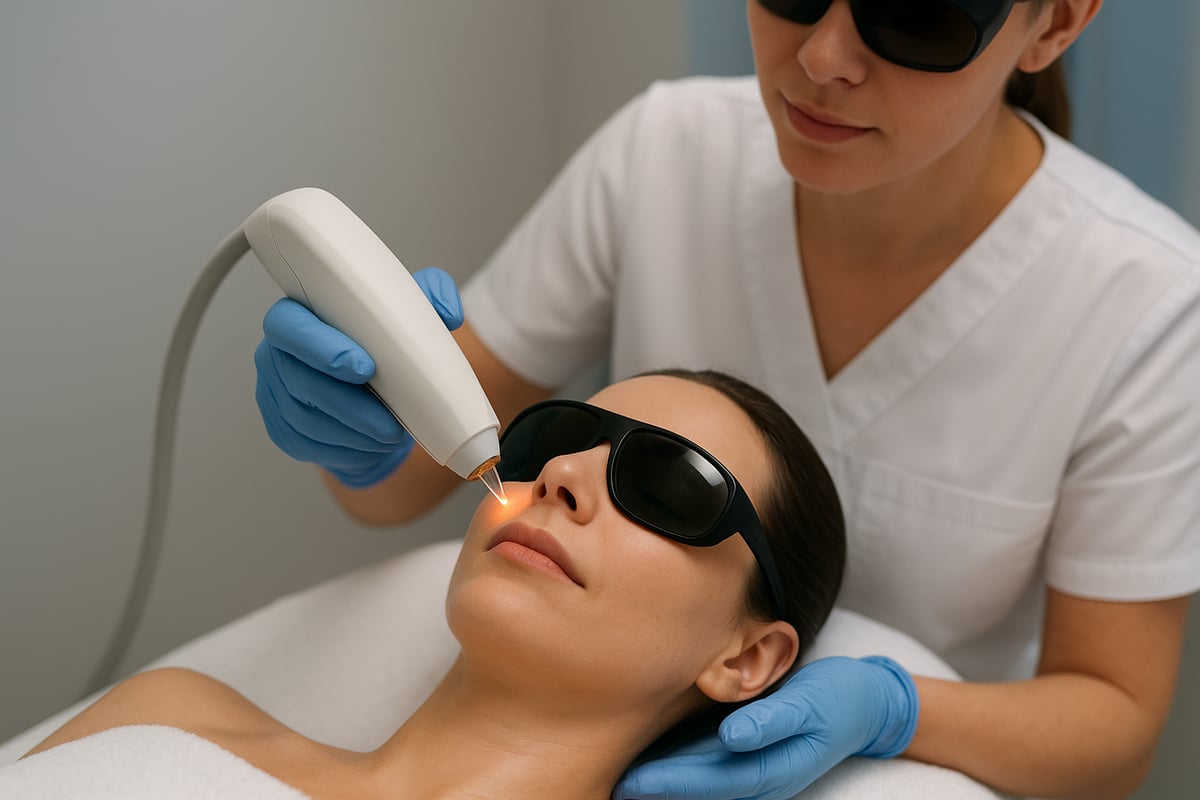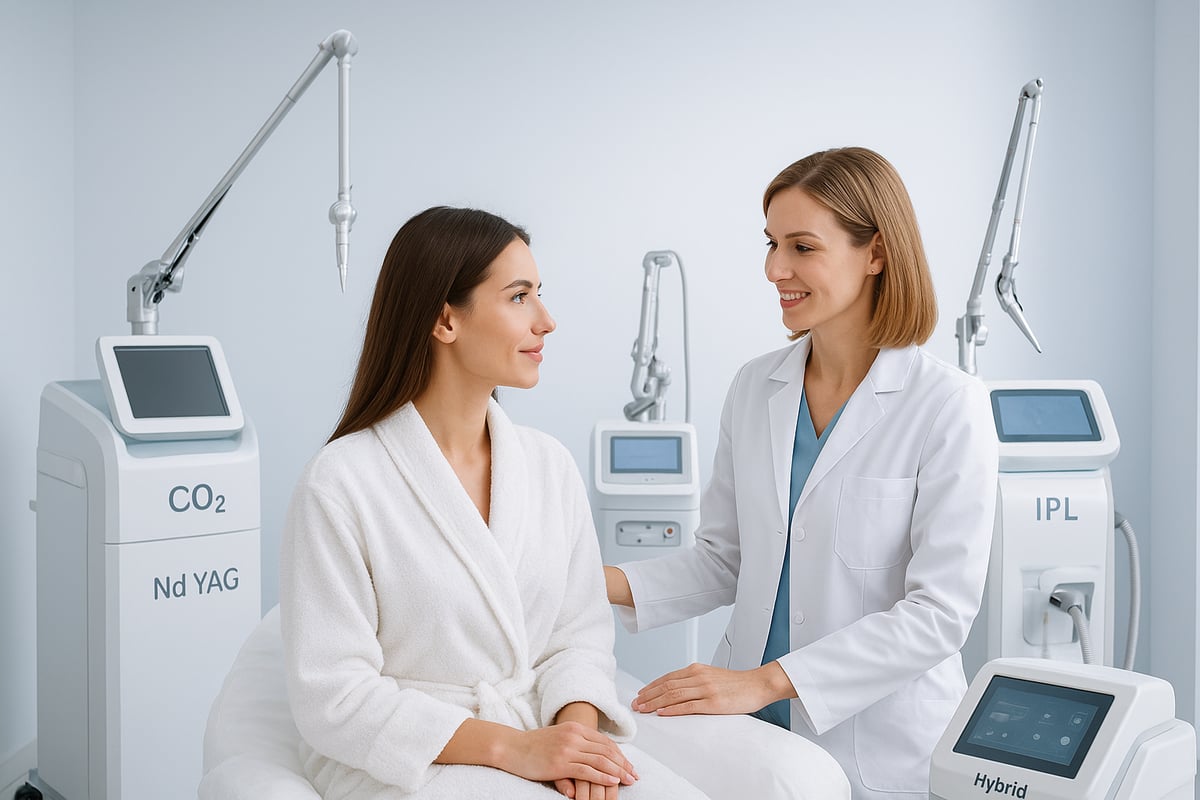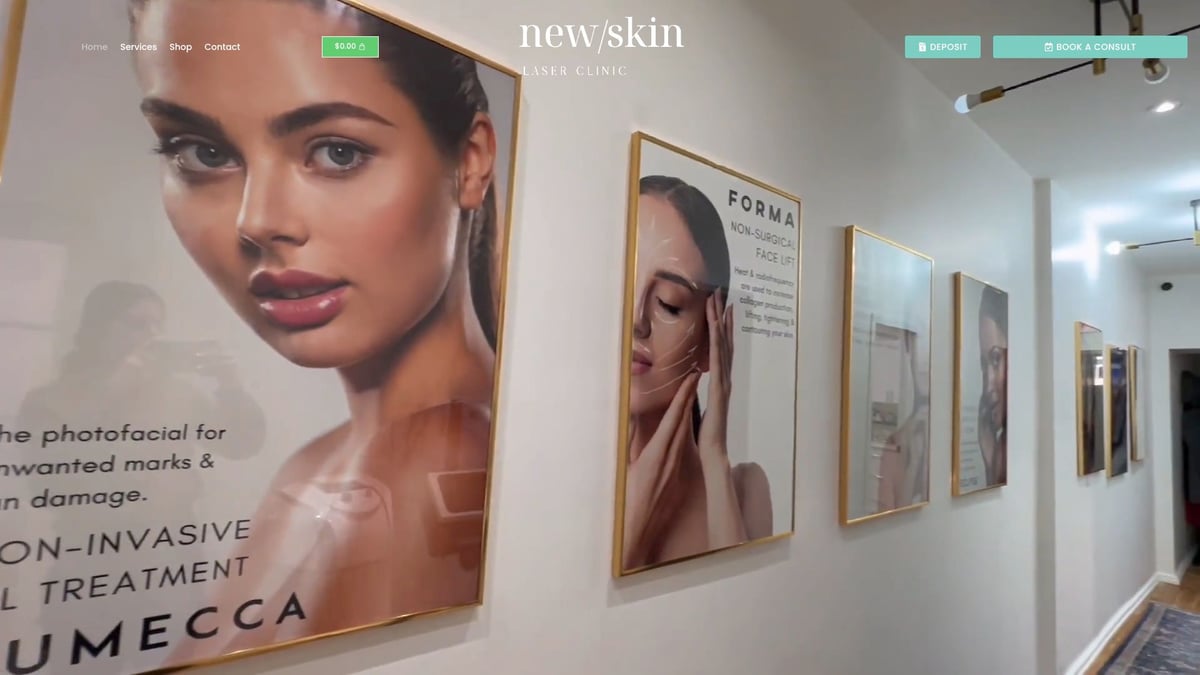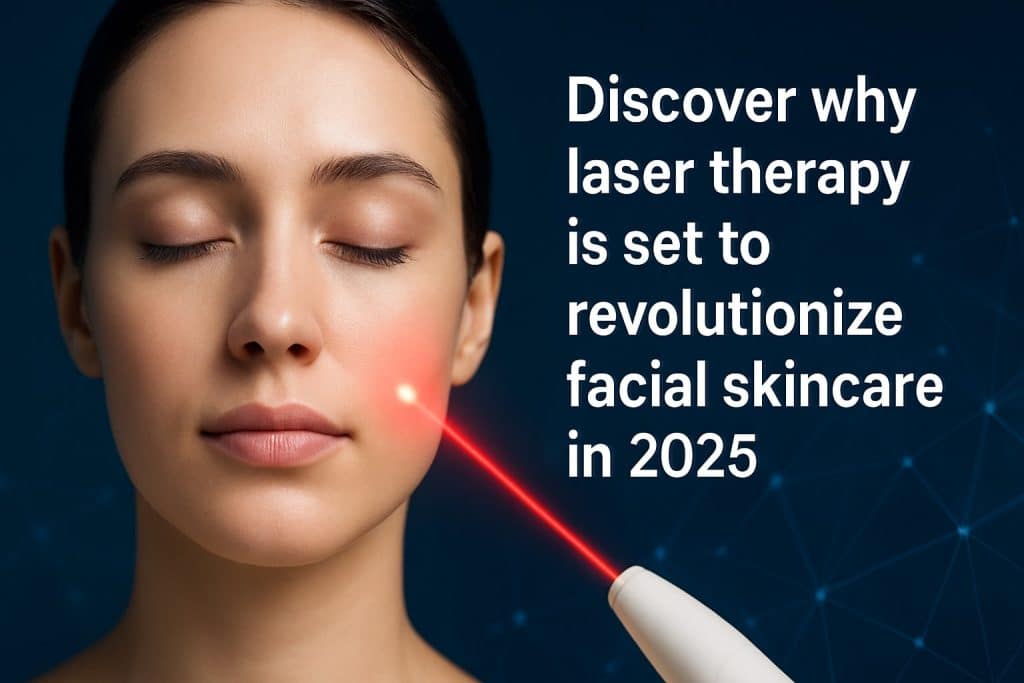Curious about the next big breakthrough in skincare? In 2025, laser therapy for face is poised to transform how we achieve radiant, youthful skin.
This comprehensive guide will walk you through the latest advancements, revealing both the benefits and potential risks of these innovative treatments.
You will gain evidence-based insights, empowering you to make informed choices about facial laser procedures.
Discover the science behind laser therapy for face, compare cutting-edge technologies, understand safety and candidacy, and explore expert tips for optimal results.
Ready to unlock the secrets of modern skin rejuvenation? Let’s begin your journey to confident, revitalized skin.
Understanding Laser Therapy for the Face
Laser therapy for face is transforming how we approach modern skincare. At its core, this technology uses focused light energy to target specific skin structures. Different wavelengths reach various skin depths, allowing for precise treatment of concerns. The most common types are ablative, non-ablative, and fractional lasers. Ablative lasers, like CO2, remove outer layers for deep resurfacing. Non-ablative lasers, such as Nd:YAG, work beneath the surface without harming the top layer. Fractional lasers deliver energy in micro-columns, speeding up healing. These mechanisms stimulate collagen, break down pigment, and treat vascular issues. For example, fractional CO2 lasers excel at deep resurfacing, while IPL is effective for pigmentation. According to a 2023 review, fractional lasers can boost collagen by up to 40% in treated areas.

The Science Behind Laser Therapy
Lasers interact with the skin at both cellular and tissue levels. The energy targets water, pigment, or blood vessels, depending on the wavelength. Ablative lasers vaporize damaged skin cells, stimulating rapid regeneration. Non-ablative lasers heat underlying tissue to trigger collagen production without disrupting the surface. Fractional lasers create tiny zones of controlled injury, leaving surrounding tissue intact for faster recovery. Collagen stimulation, pigmentation targeting, and vascular lesion treatment are core mechanisms. As an example, fractional CO2 lasers are used for deep resurfacing, while IPL devices excel at correcting sun damage. Studies indicate that fractional lasers can increase collagen production by up to 40% in treated areas, underscoring their effectiveness in laser therapy for face.
Common Facial Concerns Treated by Laser
Laser therapy for face addresses a wide range of aesthetic concerns, delivering targeted solutions for different skin needs. Some of the most common issues treated include:
- Fine lines and wrinkles
- Hyperpigmentation, sun damage, melasma
- Acne scars and enlarged pores
- Vascular lesions like rosacea or broken capillaries
- Skin laxity and texture irregularities
For example, IPL treatments can reduce sun spots by 70% after just three sessions, according to competitor data. This versatility makes laser therapy for face a preferred option for those seeking comprehensive rejuvenation.
Key Benefits of Laser Facial Treatments
Opting for laser therapy for face offers several distinct advantages over traditional methods. Many procedures are non-invasive or minimally invasive, providing precision targeting for personalized results. Recovery times are typically shorter compared to surgical alternatives, and the effects can last for months or even years. Patients benefit from long-lasting skin rejuvenation with minimal disruption to daily life. In Toronto, clinics specializing in Laser Skin Resurfacing provide advanced options tailored to individual needs. According to an industry survey, 85% of patients reported satisfaction with their laser facial rejuvenation results in 2024.
Risks and Limitations
Despite the benefits, laser therapy for face is not without risks. Potential side effects include redness, swelling, and temporary pigmentation changes. Certain skin types, especially those with higher Fitzpatrick scores, require special settings to avoid complications. Active infections or recent tanning are contraindications. It is crucial to choose a qualified provider who conducts thorough pre-treatment screening. For example, Fitzpatrick skin types IV to VI need customized parameters to reduce the risk of hyperpigmentation. Industry data notes a 1-3% chance of post-inflammatory hyperpigmentation after aggressive resurfacing, highlighting the need for careful assessment.
Latest Innovations in 2025
The landscape of laser therapy for face is rapidly evolving. New technologies like picosecond lasers and hybrid fractional devices are making treatments safer and more effective for all skin tones. AI-guided protocols are also enhancing customization, ensuring optimal results for diverse patients. These advances are setting new standards for safety and efficacy in facial laser therapy.
Types of Laser Treatments for the Face in 2025
Advancements in laser therapy for face have led to a diverse array of treatment options in 2025. Understanding the unique benefits, mechanisms, and suitability of each technology can help you make informed choices for your skin goals.

Ablative vs. Non-Ablative Lasers
Ablative lasers remove the outer layers of skin to trigger regeneration and are ideal for deeper wrinkles, scars, and significant texture issues. Non-ablative lasers, on the other hand, heat underlying skin tissue without removing the surface, targeting milder concerns with minimal downtime.
Here is a comparison:
| Type | Depth | Recovery Time | Best for |
|---|---|---|---|
| Ablative (CO2) | Deep | 5-7 days | Severe wrinkles, scars |
| Non-Ablative (Nd YAG) | Superficial | 1-3 days | Pigmentation, mild aging |
Choosing the right option in laser therapy for face depends on your skin type, concern severity, and desired downtime.
Fractional Laser Technology
Fractional lasers have transformed laser therapy for face by delivering energy in a grid of micro-columns, treating small zones while leaving surrounding tissue intact. This approach accelerates healing and reduces risks compared to traditional full-field lasers.
Fractional technologies are widely used for:
- Wrinkle reduction
- Scar revision
- Improving texture
A 2024 clinical study found that fractional lasers can reduce acne scars by up to 75 percent after three sessions. For those seeking significant results with less downtime, fractional laser therapy for face is a top choice.
Intense Pulsed Light (IPL) and Photofacials
Intense Pulsed Light (IPL) is not a true laser but uses broad-spectrum light to treat pigmentation, redness, and sun damage. IPL photofacials are popular in laser therapy for face, especially among younger individuals seeking maintenance and prevention.
Key IPL benefits:
- Reduces sun spots and freckles
- Treats visible blood vessels
- Minimal discomfort and no downtime
Unlike single-wavelength lasers, IPL can target multiple concerns in one session. Many clinics recommend IPL as a gentle introduction to laser therapy for face.
Picosecond and Nanosecond Lasers
Picosecond and nanosecond lasers deliver ultra-short pulses to shatter pigment particles and stimulate skin renewal. In 2025, picosecond lasers have become a breakthrough for treating stubborn melasma and revitalizing skin with faster recovery than older devices.
For advanced pigmentation and tattoo removal, Picoway Laser for Pigmentation is a leading choice in laser therapy for face, offering precision and reduced risk of side effects. Studies show picosecond lasers provide up to 30 percent quicker healing compared to traditional Q-switched lasers.
Combination and Hybrid Laser Treatments
Combination and hybrid laser treatments are redefining laser therapy for face in 2025. These protocols blend ablative and non-ablative energies in one session, addressing multiple skin issues efficiently.
Popular hybrid approaches include:
- Simultaneous resurfacing and pigmentation correction
- Customizable settings for different skin types
- Fewer sessions for comprehensive results
Hybrid fractional lasers are especially favored for patients looking for significant rejuvenation without extended downtime. This next generation of laser therapy for face ensures tailored solutions for all complexions.
Who is a Candidate for Facial Laser Therapy?
Choosing whether you are a good candidate for laser therapy for face starts with understanding your unique skin characteristics, lifestyle, and personal goals. The right approach ensures both safety and optimal results. Let’s break down the essential factors every prospective patient should consider.

Skin Types and Fitzpatrick Scale Considerations
The Fitzpatrick scale classifies skin into six types based on complexion and reaction to sunlight. This scale is vital in determining the safest options for laser therapy for face. For example, skin types I-III (fair to light brown) often respond well to a variety of lasers, like CO2, for resurfacing. In contrast, types IV-VI (olive to deep brown/black) require careful selection, often favoring devices such as Nd:YAG, which minimize risks of hyperpigmentation.
| Fitzpatrick Type | Skin Tone Description | Recommended Lasers |
|---|---|---|
| I–III | Fair to light brown | CO2, Er:YAG, IPL |
| IV–VI | Olive to deep brown | Nd:YAG, fractional |
A professional evaluation will match your Fitzpatrick type with the optimal laser settings, ensuring safety and effective results.
Age, Health, and Lifestyle Factors
Age plays a role in both preventive and corrective applications of laser therapy for face. Those in their late 20s to 40s often seek treatments for early signs of aging, while more mature candidates address deeper wrinkles or laxity. Good overall health is essential; individuals with autoimmune conditions, active infections, or who are pregnant may need to postpone treatment.
Lifestyle factors matter, too. High sun exposure, smoking, or inconsistent skincare can impact both candidacy and outcomes. According to Non-Surgical Aesthetics Statistics 2025, more patients are embracing proactive skin health routines, making laser therapy for face increasingly popular among various age groups.
Consultation and Assessment Process
A comprehensive consultation is the foundation of successful laser therapy for face. This process typically includes a detailed medical history review, assessment of skin concerns, and discussion of personal goals. In 2025, advanced digital skin imaging is often used to document baseline conditions and customize treatment plans.
During the assessment, your provider will examine your skin’s tone, texture, and any underlying conditions. They will also explain the different technologies available, ensuring you receive a tailored approach that maximizes both safety and results.
Realistic Expectations and Treatment Planning
Setting realistic expectations is a key step in laser therapy for face. While many patients notice improvements after just one session, optimal results often require a series of three to five treatments. Your provider will explain the expected timeline for visible changes, including when to anticipate peak results and how long they may last.
Maintenance sessions may be recommended every six to twelve months, depending on your skin type and lifestyle. Combination therapies or additional skincare adjustments might be suggested for enhanced, long-lasting rejuvenation. Open communication ensures you know what to expect and how to achieve your best outcome.
The Laser Facial Treatment Process: Step-by-Step
Embarking on laser therapy for face involves a carefully orchestrated process designed to maximize safety, comfort, and results. By understanding each stage, you can approach your treatment with confidence and realistic expectations.
Pre-Treatment Preparation
Preparing for laser therapy for face is crucial for optimal outcomes and minimizing risks. Your provider will offer a tailored checklist, but general steps include:
- Avoiding direct sun exposure for at least 2 weeks prior
- Discontinuing retinoids, exfoliants, and certain medications one week before
- Completing a patch test, especially for sensitive or darker skin
These measures help reduce the likelihood of adverse reactions and ensure the laser interacts safely with your skin. Patients are advised to hydrate well and arrive at the clinic with a freshly cleansed face, free of makeup and lotions. Open communication about allergies and recent treatments is essential for your safety.
What Happens During the Procedure?
A typical laser therapy for face session begins with thorough cleansing and the application of a topical numbing cream to enhance comfort. Once numb, you will wear protective eyewear as the clinician selects the appropriate device and settings based on your skin type and goals.
The provider then applies the laser in precise passes across the treatment area. Sensations are often described as a warm pulse or a light snapping on the skin. For example, devices like the Candela GentleMax Pro Laser offer adjustable wavelengths for different concerns, improving both safety and efficacy. Most sessions last 20 to 60 minutes, depending on the area and technology used.
Immediate Post-Treatment Care
Right after laser therapy for face, your skin will likely feel warm and appear red, similar to a mild sunburn. Providers typically apply soothing serums such as hyaluronic acid and recommend cooling with cold compresses. Strict sun protection is vital to prevent complications.
Your aftercare instructions may include:
- Using gentle, fragrance-free cleansers and moisturizers
- Applying mineral SPF 50+ daily
- Avoiding makeup, exfoliants, and actives for 7 to 10 days
Following these recommendations supports healing and reduces the risk of irritation or pigmentation changes. Most patients find symptoms subside within 24 to 72 hours.
Recovery Timeline and Downtime
Downtime varies depending on the type and intensity of laser therapy for face. Non-ablative lasers offer minimal recovery, while ablative lasers may require more rest. The following table summarizes typical recovery periods:
| Laser Type | Redness/Swelling | Peeling/Flaking | Return to Activities |
|---|---|---|---|
| Non-Ablative | 1-3 days | Mild, rare | 24-48 hours |
| Ablative | 5-7 days | Moderate | 7+ days |
| Fractional | 2-5 days | Mild-Moderate | 3-5 days |
Most non-ablative laser patients resume normal routines within 48 hours, while more intensive treatments may require up to a week for full recovery.
Managing Side Effects and Complications
While laser therapy for face is generally safe, minor side effects like redness, swelling, and mild discomfort are common. Recognizing normal versus concerning symptoms is key:
- Normal: Pinkness, mild swelling, slight peeling
- Concerning: Persistent pain, yellow discharge, fever, or spreading redness
Promptly contact your provider if you notice signs of infection or prolonged swelling. For patients with darker skin tones, specific laser settings and pre/post-care strategies help minimize the risk of hyperpigmentation. Your clinic should provide clear instructions for managing any unexpected reactions.
Results: What to Expect and When
Results from laser therapy for face can appear as early as a few days post-treatment, with an initial glow and smoother texture. Over the following weeks, collagen production increases, leading to firmer, more radiant skin. Some improvements, such as pigmentation reduction, may take several sessions to achieve full effect.
On average, 70% of patients report visible improvement after just one session. Results can last months to years, depending on the type of laser and your aftercare diligence. Regular follow-ups and a healthy skincare routine help sustain your rejuvenated look.
Choosing the Right Laser Clinic and Provider
Selecting the right provider is one of the most important steps when considering laser therapy for face. Your choice impacts results, safety, and overall satisfaction. Let’s break down what to look for in a clinic and practitioner before beginning your journey.
Credentials and Experience
When seeking laser therapy for face, prioritize clinics led by board-certified dermatologists or licensed medical professionals. Experience matters—providers with extensive training and a solid track record are better equipped to handle diverse skin types and unexpected complications.
Ask about the clinic’s history with your specific skin concerns. Inquire about certifications, ongoing education, and familiarity with the latest laser technologies. Clinics with more than five years of experience often report fewer complications and higher patient satisfaction rates.
Choose a provider who listens to your goals, explains procedures clearly, and tailors treatments to your unique needs. Personalized care is essential for optimal outcomes.
Technology and Equipment Standards
The technology used for laser therapy for face directly affects your safety and results. Modern clinics invest in state-of-the-art lasers, offering multiple platforms to match various skin types and treatment goals.
Advanced clinics often utilize AI-assisted devices for greater precision and customization. Outdated equipment can increase the risk of side effects or deliver subpar outcomes. As the Aesthetic Lasers Market Size Forecast shows, the demand for noninvasive procedures and technological advancements continues to rise, making equipment quality even more essential.
Before booking, verify the clinic’s device certifications and ask how they ensure equipment is regularly maintained and updated.
New Skin Laser Clinic: Expert Laser Facial Treatments in Toronto
New Skin Laser Clinic stands out as a premier destination for laser therapy for face in Toronto. Their team of expert estheticians and a registered nurse deliver advanced laser facial treatments in a safe, welcoming environment.

Personalized consultations ensure each client receives a tailored treatment plan for their skin type and goals. The clinic’s state-of-the-art technology allows them to treat all skin tones safely and effectively.
With over 100 five-star reviews, flexible payment options, and a reputation for excellence, New Skin Laser Clinic is a trusted choice for those seeking optimal results.
Cost, Packages, and Financing
Understanding the cost of laser therapy for face is crucial for planning. In 2025, prices typically range from $200 to $1500 per session, depending on the technology and treatment area.
Many clinics offer package deals or seasonal promotions, making it more affordable to complete a full course of sessions. Financing options like “Buy Now, Pay Later” are increasingly popular, helping patients manage the investment in their skin’s health.
During your consultation, request a detailed cost breakdown, ask about available packages, and explore flexible payment plans to ensure the best value for your treatment.
Maximizing Results and Long-Term Skin Health
Unlocking the full benefits of laser therapy for face goes beyond the initial treatment. Post-procedure care, thoughtful combination therapies, and healthy lifestyle choices all play a crucial role in sustaining your results. Explore these expert strategies to maximize your glow and protect your investment for years to come.
Aftercare Essentials and Skincare Regimens
Proper aftercare is foundational to achieving optimal results from laser therapy for face. Immediately following your session, gentle cleansing with a mild, fragrance-free cleanser helps prevent irritation. Hydration is vital—apply a soothing, non-comedogenic moisturizer to restore the skin barrier.
Daily sun protection is non-negotiable. Use a mineral SPF 50+ sunscreen to shield treated skin from UV damage. Avoid exfoliants, retinoids, or acids for 7 to 10 days post-procedure, as these can trigger sensitivity or delay healing.
A simple post-laser routine might include:
- Fragrance-free cleanser
- Hyaluronic acid serum
- Rich, gentle moisturizer
- Mineral-based sunscreen
By following these guidelines, you give your skin the best environment to heal and flourish after laser therapy for face.
Combining Laser Therapy with Other Treatments
For enhanced outcomes, many clinics recommend combining laser therapy for face with complementary modalities. One popular approach is pairing laser resurfacing with microneedling, which boosts collagen production and accelerates recovery. Treatments like injectables or professional facials can also be strategically timed to amplify results.
A notable trend for 2025 is the rise of “stacked” therapies. For example, a session might include both laser rejuvenation and a Eclipse Microneedling for Skin Renewal procedure for improved skin texture and radiance.
Consult with your provider to design a personalized plan that safely integrates multiple treatments, maximizing the benefits of laser therapy for face.
Maintenance Schedules and Repeat Sessions
To preserve your investment in laser therapy for face, regular maintenance is essential. Most patients benefit from touch-up sessions every 6 to 12 months, depending on age, skin type, and lifestyle factors.
A typical maintenance schedule includes:
- Annual or biannual laser treatments
- Consistent home skincare routine
- Periodic professional assessments
Data from recent surveys show that 60% of patients opt for annual refreshers to sustain their results. By adhering to a tailored maintenance plan, you can enjoy the benefits of laser therapy for face for years.
Addressing Pigmentation and Scarring Long-Term
Long-term management of pigmentation and acne scarring requires a strategic approach after laser therapy for face. Prevent recurrence by using topical antioxidants, such as vitamin C serums, which help protect skin from environmental stressors. Prescription creams, like retinoids, may also be recommended between sessions to support ongoing renewal.
Consider these strategies:
- Apply vitamin C serum daily
- Use prescription retinoids as advised
- Schedule periodic check-ins with your provider
By staying proactive, you can reduce the likelihood of pigment return or new breakouts, optimizing your results from laser therapy for face.
Lifestyle Factors for Prolonged Benefits
Your daily habits significantly impact the longevity of your laser therapy for face results. Prioritize a balanced diet, adequate hydration, restful sleep, and effective stress management. Avoid triggers like smoking, excessive sun exposure, or harsh skincare products, as these can compromise your progress.
A 2024 survey found that patients who embraced healthy lifestyles reported 30% longer-lasting effects from their treatments. Small changes, such as wearing a hat outdoors or choosing antioxidant-rich foods, can make a big difference in preserving the benefits of laser therapy for face.
Myths and Facts About Laser Facial Therapy
Misinformation about laser therapy for face is common. Let us clarify:
| Myth | Fact |
|---|---|
| “Results are instant” | Improvement is gradual as collagen remodels |
| “It’s too painful” | Most experience only mild discomfort |
| “Not safe for dark skin” | Advanced lasers can be customized for all tones |
| “Downtime is always long” | Many modern treatments have minimal recovery |
Armed with evidence-based knowledge, you can make confident choices about laser therapy for face in 2025.

